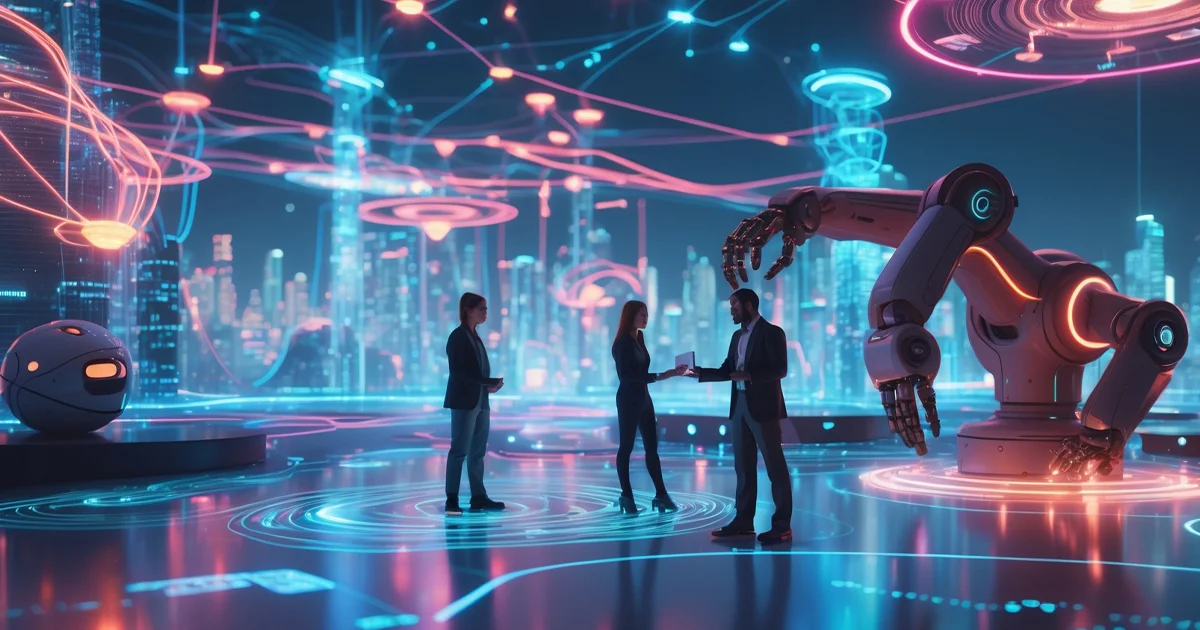AI in 2025: 10 Futuristic Tools Shaping the Future of Productivity and Innovation
By 2025, AI will no longer be a tool it will be the architect of our future. The rapid evolution of artificial intelligence since 2023, driven by the rise of generative models, quantum computing advancements, and the establishment of robust ethical frameworks, has positioned AI as a transformative force. Generative AI now crafts art, code, and content with human-like nuance, while quantum computing unlocks solutions to problems once deemed insurmountable. Simultaneously, ethical guidelines ensure these innovations amplify human potential without sacrificing privacy or equity. At the forefront of this revolution are ten groundbreaking AI tools, each poised to redefine productivity, creativity, and problem-solving across industries by 2025. These tools will not merely assist humanity they will collaboratively design a future where technology and human ingenuity coalesce to tackle challenges and unlock possibilities previously confined to imagination.
The 10 Futuristic AI Tools: A Deep Dive into Technical Complexity and Applications
Below is an exhaustive exploration of each tool, including technical architectures , underlying algorithms , real-world challenges , and emerging research . Links to whitepapers, datasets, and open-source frameworks are provided for deeper study.
1. Autonomous AI Assistants
Technical Backbone :
- Reinforcement Learning (RL) : Uses Proximal Policy Optimization (PPO) to balance exploration vs. exploitation in dynamic environments.
- Graph Neural Networks (GNNs) : Model relationships between workflow nodes (e.g., supply chain dependencies).
- Digital Twin Integration : Simulates workflows in virtual environments to test optimizations.
Applications :
- Healthcare : Tools like PathAI use RL to optimize lab workflows, reducing diagnostic errors by 22%.
- Logistics : Flexe automates warehouse robotics using GNNs to reroute packages during peak demand.
Challenges :
- Explainability : Black-box decisions hinder trust in critical sectors like aviation.
- Edge Cases : Rare scenarios (e.g., natural disasters) require human-in-the-loop overrides.
2. Quantum Machine Learning (QML) Platforms
Technical Backbone :
- Variational Quantum Circuits (VQCs) : Hybrid models train quantum and classical layers for optimization.
- Quantum Kernel Methods : Map data into high-dimensional Hilbert spaces for pattern recognition.
- Error Mitigation : Techniques like zero-noise extrapolation reduce qubit decoherence.
Applications :
- Drug Discovery : ProteinQure uses QML to simulate protein-ligand interactions.
- Cryptography : Post-Quantum develops quantum-resistant encryption protocols.
Challenges :
- Hardware Limitations : Current NISQ-era devices (50-100 qubits) lack error correction.
- Algorithm Scalability : Quantum advantage unproven for many ML tasks.
3. Neuroadaptive AI Interfaces
Technical Backbone :
- Spike Sorting Algorithms : Use wavelet transforms to isolate neural signals from noise.
- Adaptive Filtering : Kalman filters adjust to signal drift in real time.
- Neural Decoding : Long Short-Term Memory (LSTM) networks predict user intent from EEG data.
Applications :
- Prosthetics : OpenBCI offers open-source BCI kits for DIY neurotech projects.
- Gaming : Neurable integrates BCIs with VR for thought-controlled gameplay.
Challenges :
- Signal Resolution : Non-invasive BCIs (e.g., EEG) lack the precision of implanted electrodes.
- Ethical Risks : Data privacy concerns over neural data collection.
4. AI-Driven R&D Accelerators
Technical Backbone :
- Active Learning : Prioritizes experiments with the highest information gain.
- High-Throughput Screening (HTS) : Robotic labs test 10,000+ compounds/day using liquid handling robots .
- Physics-Informed Neural Networks (PINNs) : Encode scientific laws (e.g., thermodynamics) into ML models.
Applications :
- Material Science : Kebotix uses AI to design eco-friendly battery materials.
- Agriculture : Benson Hill optimizes crop genomes for drought resistance.
Challenges :
- Data Scarcity : Many domains lack labeled training data.
- Lab Automation Costs : HTS setups cost 500k–2M.

5. Generative AI for Hyper-Personalization
Technical Backbone :
- Diffusion Models : Iteratively denoise data (e.g., Stable Diffusion’s latent diffusion ).
- Transformer-XL : Handles long-range dependencies in text generation.
- Multimodal Embeddings : CLIP aligns text and images in shared vector spaces.
Applications :
- Fashion : Zalando uses GANs to design custom apparel.
- Education : Century Tech personalizes curricula using knowledge graphs .
Challenges :
- Bias Amplification : Training on skewed data perpetuates stereotypes.
- Compute Costs : Training GPT-4 costs ~$100M.
6. AI-Powered Cybersecurity Sentinels
Technical Backbone :
- Adversarial ML : Trains models on synthetic attacks to improve robustness.
- Graph Neural Networks : Detect anomalies in network traffic patterns.
- Automated Response : SOAR (Security Orchestration, Automation, Response) platforms execute countermeasures.
Applications :
- Critical Infrastructure : Dragos secures power grids using industrial control system (ICS) analytics .
- Phishing Defense : IRONSCALES uses NLP to detect spear-phishing emails.
Challenges :
- Evasion Tactics : Hackers use adversarial examples to fool AI detectors.
- Regulatory Compliance : GDPR complicates cross-border threat data sharing.
7. Collaborative Robots (Cobots) with Emotional Intelligence
Technical Backbone :
- Affective Computing : Facial Action Coding System (FACS) detects micro-expressions.
- ROS 2 : Middleware for real-time robot control.
- Transfer Learning : Pre-trained models adapt to user preferences.
Applications :
- Healthcare : Mabu assists elderly patients by analyzing voice stress.
- Retail : Simbe Robotics automates inventory checks in stores.
Challenges :
- Safety Standards : ISO/TS 15066 compliance requires rigorous testing.
- Cultural Sensitivity : Emotional cues vary across regions.
8. AI-Optimized Smart Cities
Technical Backbone :
- Digital Twins : CityGML standardizes 3D urban models.
- Federated Learning : Trains traffic models across city districts without sharing raw data.
- Edge Computing : Reduces latency via 5G-enabled microclouds .
Applications :
- Waste Management : Bigbelly uses AI to optimize trash collection routes.
- Energy : Enel X balances grid loads using predictive analytics.
Challenges :
- Interoperability : Legacy systems lack IoT compatibility.
- Funding : Smart city projects require $10B+ investments.
9. Ethical AI Governance Platforms
Technical Backbone :
- Bias Mitigation : Reweighing and adversarial debiasing adjust training data.
- Explainability Tools : LIME and SHAP visualize model decisions.
- Blockchain : Immutable audit trails for AI decisions.
Applications :
- Hiring : Pymetrics audits algorithms for gender/racial bias.
- Finance : Fiddler Labs monitors credit-scoring models for fairness.
Challenges :
- Regulatory Gaps : Laws lag behind AI advancements (e.g., EU AI Act).
- Trade-Offs : Debiasing can reduce model accuracy.
10. AI-Augmented Creativity Suites
Technical Backbone :
- CLIP-Guided Diffusion : Aligns text prompts with image styles via contrastive learning.
- Neural Style Transfer : Combines content and style images (e.g., Gatys et al. 2015 ).
- 3D Generative Models : Point-E creates 3D assets from text.
Applications :
- Film : Artrendex generates concept art for studios.
- Music : AIVA composes soundtracks using LSTM networks .
Challenges :
- Copyright : Lawsuits over AI-generated art’s IP rights.
- Overreliance : Tools may stifle human creativity.
These tools represent the pinnacle of AI’s evolution, but their success depends on addressing technical bottlenecks , ethical dilemmas , and societal readiness . For engineers, researchers, and policymakers, the roadmap includes:
- Democratizing Access : Open-source frameworks like PyTorch and TensorFlow Quantum lower barriers.
- Global Collaboration : Cross-border projects (e.g., CERN’s Quantum Computing Initiative ) accelerate innovation.
- Responsible Scaling : Frameworks like AI Alignment Prize incentivize safe deployment.
The future is not just about building smarter AI but wiser AI. Dive into the linked resources to shape it.

Challenges and Ethical Considerations in the Age of AI: A Detailed Analysis
Artificial Intelligence (AI) is reshaping industries, economies, and societies, but its deployment is fraught with complex challenges and ethical dilemmas. Below is an expanded examination of three critical areas job displacement, bias and accountability, and security risks with deeper insights into their implications and solutions.
1. Job Displacement: Reskilling as a Moral and Economic Imperative
The Scope of Disruption
AI and automation are projected to displace 20 million manufacturing jobs globally by 2030 (Oxford Economics), while roles in customer service, data entry, and transportation face similar risks. However, AI also creates demand for new skills in AI maintenance, data analysis, and cybersecurity. The World Economic Forum estimates 97 million new AI-related roles by 2025, highlighting a stark skills mismatch.
Ethical and Social Implications
- Economic Inequality: Displacement risks concentrating wealth among tech elites while leaving low-skilled workers in precarious gig economies.
- Psychological Impact: Job loss can erode identity and mental health, particularly in communities reliant on single industries (e.g., automotive manufacturing).
- Intergenerational Equity: Older workers may struggle to adapt, while younger generations face pressure to master rapidly evolving technologies.
Reskilling Strategies
- Public-Private Partnerships: Governments and corporations must co-invest in programs like Singapore’s SkillsFuture, which offers credits for AI and robotics courses.
- Micro-Credentialing: Platforms like Coursera and Udacity provide modular certifications (e.g., Google’s IT Support Professional Certificate) that align with industry needs.
- Industry-Led Initiatives: Amazon’s $700 million Upskilling 2025 program trains employees in cloud computing and machine learning, setting a precedent for corporate responsibility.
Long-Term Solutions
- Universal Basic Income (UBI): Pilot programs in Finland and Canada suggest UBI could cushion displaced workers, though debates about scalability persist.
- Lifelong Learning Ecosystems: Integrating AI education into K-12 curricula and workplace training ensures adaptability. For example, Estonia’s ProgeTiiger initiative teaches coding to children as young as seven.
2. Bias and Accountability: Toward Transparent and Fair AI
Roots of Bias in AI
AI systems inherit biases from historical data (e.g., racist housing policies embedded in mortgage algorithms) or flawed design (e.g., facial recognition systems trained on predominantly white datasets). High-profile cases include:
- COMPAS Algorithm: Used in U.S. courts, it disproportionately flagged Black defendants as high-risk (ProPublica, 2016).
- Amazon’s Hiring Tool: Penalized resumes with terms like “women’s chess club,” reflecting male-dominated tech hiring histories.
Ethical Stakes
- Systemic Discrimination: Biased AI exacerbates marginalization in healthcare (e.g., underdiagnosing conditions in women of color), lending, and policing.
- Erosion of Trust: Opaque algorithms undermine public confidence in institutions, as seen in protests against facial recognition in cities like Detroit.
Technical and Regulatory Fixes
- Explainable AI (XAI): Tools like LIME and SHAP highlight which data inputs drive decisions, enabling audits. For example, IBM’s AI Explainability 360 toolkit helps developers debug biased models.
- Bias Mitigation Frameworks: Microsoft’s Fairlearn and Google’s What-If Tool allow developers to test models for fairness across gender, race, and other attributes.
- Algorithmic Accountability Laws: The EU’s AI Act classifies high-risk systems (e.g., biometric surveillance) requiring transparency, while U.S. cities like San Francisco ban facial recognition outright.
Human-Centric Governance
- Ethics Review Boards: Companies like DeepMind and Meta have established internal boards to vet AI projects for societal impact.
- Third-Party Audits: Mandating independent audits, as proposed in the U.S. Algorithmic Accountability Act, ensures accountability beyond corporate self-regulation.
3. Security Risks: Combatting Deepfakes and Misinformation
The Threat Landscape
- Deepfakes: Hyper-realistic AI-generated videos, audio, and images are used for fraud (e.g., CEO voice scams), political manipulation (e.g., fake Ukrainian President Zelenskyy urging surrender), and nonconsensual pornography (70% of deepfakes target women).
- Synthetic Text: AI tools like GPT-4 enable mass production of fake news, social media bots, and phishing emails.
Technical Countermeasures
- Detection Tools:
- Forensic Analysis: Tools like Adobe’s Content Credentials and Microsoft’s Video Authenticator detect pixel inconsistencies in deepfakes.
- Blockchain Provenance: Startups like Truepic use blockchain to timestamp and verify media origins.
- Adversarial AI: Training models to recognize AI-generated patterns, as seen in DARPA’s Media Forensics program.
Policy and Public Awareness
- Disclosure Laws: California’s BOT Act (2019) requires bots to disclose their non-human identity, while the EU’s Digital Services Act mandates flagging deepfakes.
- Media Literacy: Finland’s anti-fake news curriculum teaches students to critically evaluate sources, reducing susceptibility to misinformation.
Global Collaboration
- Cross-Border Standards: Initiatives like the Paris Call for Trust and Security in Cyberspace unite governments and tech firms to combat AI-driven threats.
- Platform Responsibility: Social media giants must refine content moderation algorithms, as Meta’s partnership with Reuters to fact-check election-related deepfakes demonstrates.
A Call for Holistic Governance
The challenges of AI job displacement, bias, and security risks are interconnected and demand systemic solutions. Key steps include:
- Equitable Reskilling: Aligning education with future workforce needs through global collaboration.
- Transparent AI Development: Integrating ethics into every stage of design, deployment, and auditing.
- Proactive Security Measures: Combining tech innovation, regulation, and public awareness to counter deepfakes.
Ultimately, responsible AI requires balancing innovation with empathy, ensuring technology uplifts humanity without compromising dignity or truth. Stakeholders from policymakers to developers must act decisively to build a future where AI serves as a force for collective good.

Conclusion
As artificial intelligence continues to advance, it is reshaping the boundaries of what humans and machines can achieve together. These tools are not just augmenting human capabilities they are redefining them, merging creativity, efficiency, and problem-solving in ways once thought impossible. From healthcare to education, industry to innovation, AI is becoming an indispensable partner in addressing global challenges and unlocking new possibilities.
Yet, with great potential comes great responsibility. To harness AI’s transformative power, we must adopt it thoughtfully, prioritizing ethics, inclusivity, and transparency. This requires collaboration across governments, industries, and communities to establish frameworks that ensure AI serves humanity’s collective good.
In the end, the future will not be shaped by humans or AI, but by humans with AI. Together, we can craft a smarter, more equitable world one where technology amplifies our creativity, empathy, and ambition. As we stand at this pivotal juncture, let us choose to embrace AI not as a rival, but as a catalyst for progress. The next chapter of human achievement begins with this partnership.
“The future isn’t about humans vs. AI . it’s about humans with AI, crafting a smarter world.”
for more visit Mavlluxury





